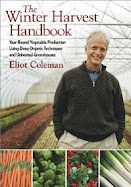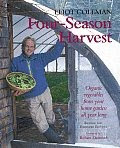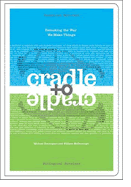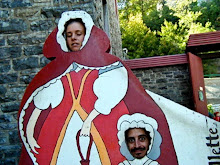Because it's such a small town, I cannot rightly share with you our results. Let's just say that we've found a hands down winner (although nowhere near as good as a Hackett's,) and are also enjoying 'off - Island' pies in secret. There have been some occasional homemade entries between us, which brings me a little closer to the heart of this post. To celebrate Riki's return from Japan, I made a special apple coffee cake from 101cookbooks.
glazed with homemade apple jelly
steaming hot
Maybe you know a bit about the genetics of apples; I'm a Michael Pollan fanatic, and was inspired to learn more about them after reading the Botany of Desire. The basics are that apple seeds do not produce offspring that resemble the trees in which they come from. A Mac doesn't make a Mac, and a Granny Smith doesn't make a Granny Smith. This unreliability is the basis of why apples are cut and grafted as opposed to started from seed (that and the ability to pair each tree to the proper rootstock for it's desired size and the local climate.) Apples from seed are rarely sweet, nor can their resistance to disease and pests be counted on.
This bit of information puts the home gardener in a pay-to-plant situation. You're unlikely to plant apples from seed on your property unless you can be sure that they will produce a variety that's to your liking. Purchasing grafted 'whips' (unbranched 4-6 ft trees on bare rootstock) can run about $12 - $20 apiece, or more for older and better established trees. Really, that's not bad. However, if you're like me, and have some zany projects in mind, then all of those numbers start to add up before you've accidentally killed your first tree.
McIntosh Seeds
I have two books in my library that inspire me to do all sorts of crazy things with trees; Arborsulpture by Richard Reames and How to Grow a Chair, again by Reames and Barbara Delbol. Both of these books are fascinating accounts of different existing arborsculptures, as well as instructions for growing fences, chairs, and even houses. Arborsculpture is a term coined by Reames that encompasses his process of treeshaping, which relies on whips that are instantly shaped. The Gradual Shaping Method was developed by Peter Cook and Becky Northey and uses small saplings, like those I intend to grow from the apple seeds. Gradual tree shaping requires planning and design to slowly shape the tree into the desired form.
Garden Chair from Pooktre Tree Shapers
Peter Cook on the Garden Chair:
"Our living garden chair started life as a single tree under 10in (20cm) tall. We had planned out the design before the tree had even start to grow. The tree was grown into the design shape over a 3 year period. We waited about 6 years before we sat on it. So it was about 9 years old. This coming spring it will be 13 years old, it is a wild plum (Prunus Myrobalan). This tree now needs no more maintenance than that of the average fruit tree in your garden."
Peter Cook on the Garden Chair:
"Our living garden chair started life as a single tree under 10in (20cm) tall. We had planned out the design before the tree had even start to grow. The tree was grown into the design shape over a 3 year period. We waited about 6 years before we sat on it. So it was about 9 years old. This coming spring it will be 13 years old, it is a wild plum (Prunus Myrobalan). This tree now needs no more maintenance than that of the average fruit tree in your garden."
Be sure to follow the link to their site to see their photo gallery and subscribe for updates!
I'm not sure exactly what I'd like to do with treeshaping - I imagine that to start I'd just play with things on a small scale for container plantings and photographs. But what I do know is that without starting the seeds, I'd actually have to buy whips - and as I'm not planning on eating any of the fruit (we have already planted enough,) so why bother? With all of this in mind, I removed the seeds from my coffee cake apple scraps and stored them in the fridge until I was ready to plant.
Later, I added seeds from a Mutsu (aka Crispin) as well as both Bosc and Anjou pears. I had a Northern Spy as well, but it had no seeds!? This time, after removing the seeds I dried them out in the oven (mine can be set at 100 degrees) as I read that this was an important step. I had lent my dehydrator to a friend, but I think that would have really sped things up. If you're using either an oven or a dehydrator, I would be careful not to go above 110 degrees if you'd like your seeds to germinate.
And then, just like that, I set them up for Winter Sowing as I had done recently with several other seeds. You could also keep them in your refrigerator for a few months if you prefer. I, myself, am not too worried about failure (with regards to experimental gardening.) I am so busy in the summer that when I screw things up it usually amounts to nothing but sweet, sweet relief.









































